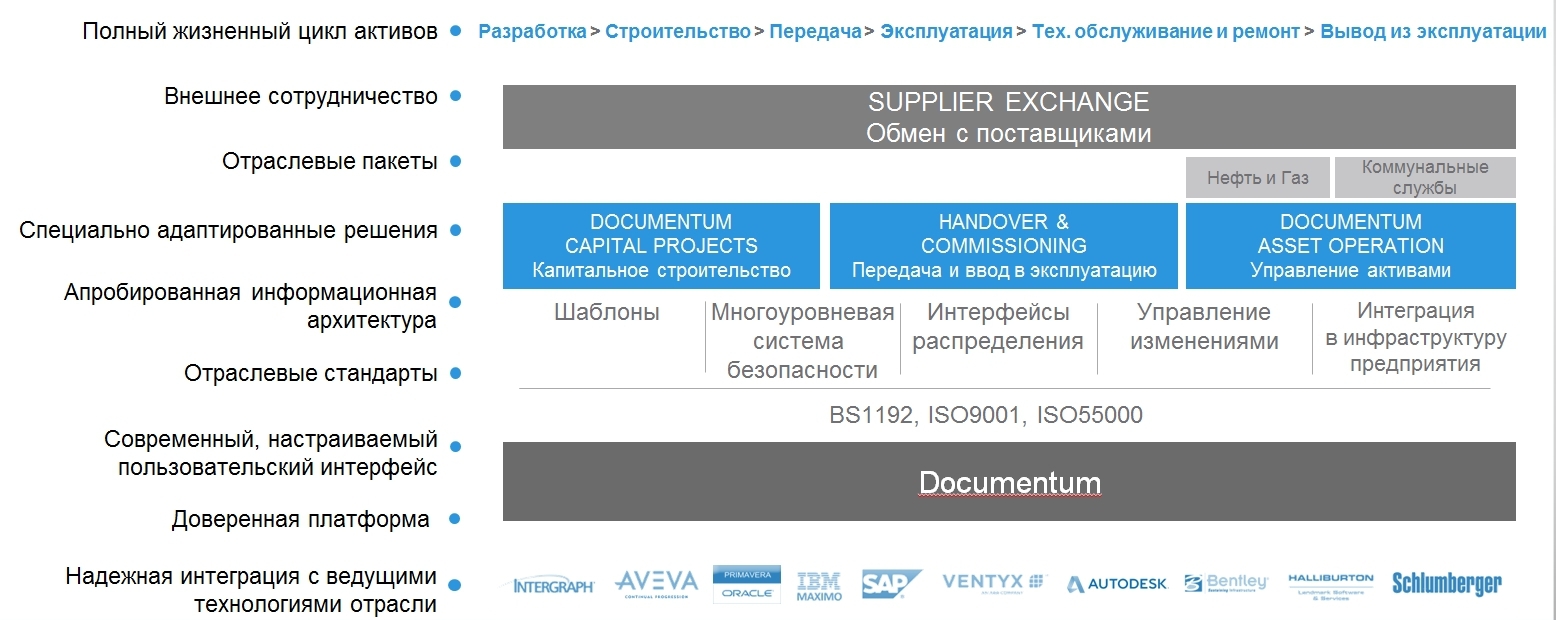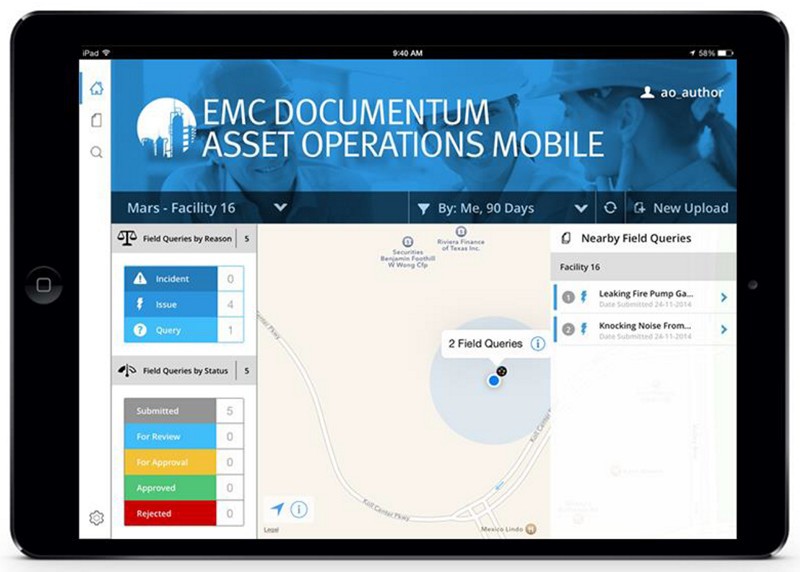What we should build a plant: EMC solutions for industrial facilities

In order to “only” build a multi-storey building, it is required to develop a bunch of documentation, sending it to numerous contractors. And when it is necessary to design and build such complex objects as enterprises of the energy, oil and gas and processing, metallurgical and engineering sectors, the volume of documentation exceeds the wildest imagination. And the number of contractors involved in all stages of design, construction and operation, can reach hundreds. Everyone needs to send the necessary part of the documentation, which goes through numerous approvals, approvals and revisions, many times plying between the participants of the process. Add to this a myriad of electronic and paper letters, faxes, financial documents, contracts and applications, and as a result you will receive a huge amount of information that is constantly moving, changing and growing. And all this, often in conditions of tight deadlines.

')
It is not surprising that the rapid and precise management of such a project - the creation and operation of an enterprise - is impossible without the use of a management system and accounting documentation. To solve this complex and time-consuming task, the EMC Documentum for Engineering, Plant and Facilities Management (EPFM) solution package is designed.
In fact, it represents a certain single source of all kinds of information about the object being created. What exactly is the task of this package?
First, storage, accounting of changes and management of all project documentation of the created object is provided. No matter how many people and teams are working on the design of the enterprise, all the documentation they create and the changes made will be saved as a single structure that allows you to quickly access the latest versions of documents. With the help of a work planning system, a schedule is formed, within which tasks for the preparation of certain documents are created. Capital Projects allows you to track the current status of these tasks.
Secondly, the process of transferring construction documents to contractors and suppliers is greatly simplified. In addition, it is much easier to control the completeness of the transmitted documentation. This allows you to reduce time costs, which is always important for any business project.
Thirdly, the specialists who exploit the finished object are able to quickly obtain all the necessary documentation on it. So when the time comes to upgrade or expand the facility, you will not have to waste time requesting the necessary documents, searching for them and waiting for arrival.
And fourthly, the availability of a complete set of documents and the history of their creation and modification allows them to meet representatives of the supervisory authorities "fully armed", and also make much faster changes and changes upon their request. Naturally, all the above possibilities are implemented with regard to the levels of tolerances to information.
A feature of the Documentum EPFM solution package is its flexibility, since it is not a single tool, but a set of components:
- Documentum Capital Projects
- Supplier Exchange
- Handover and Commissioning
- Documentum Asset Operations
Let's briefly look at each of the components separately.
Components of the Documentum EPFM Solution Package:

Documentum Capital Project
Capital Project is used at the design and construction stage of the facility. It allows you to automate and simplify many of the project development processes, the coordination of documentation and changes. With this solution, you can track the status of each document, the responsible persons, the history of the changes being made (versioned), information on the transfer to one or other participants of the process. And all this is done in accordance with the policies of standardization. Capital Project can be integrated into existing project management systems. And if the customer does not have the opportunity to deploy the Capital Project locally, then he can use the software as service option, that is, the cloud version of the product.
Supplier Exchange
The rate of exchange of documentation has a great impact on the timing of the entire project as a whole. The construction of a complex industrial facility requires constant interaction with construction organizations, with suppliers of equipment, machinery, materials and raw materials, with operators, with supervisory authorities. And documentation means not only all sorts of schemes, drawings and calculations; this and legal documents, all kinds of regulations, notices and other working correspondence. Moreover, a single document may have several recipients at once, their composition may vary depending on current conditions.
Supplier Exchange allows you to automate and speed up multiple processes for exchanging information through collaboration on documents. With it, you can coordinate the forwarded versions of documents between designers, contractors, customers and other parties. At the same time, Supplier Exchange has built-in security tools for transmitted information, which is very important for protection against industrial espionage. In addition, Supplier Exchange can be integrated with Capital Projects, which saves users from manually sending documents via mail or using the same ftp servers to transfer documentation.
Handover and Commissioning
When the facility is already built, it becomes necessary to transfer to the operators a huge array of documents from construction organizations: specifications, descriptions of standard procedures, various schemes and as-built documentation. Without this, it is impossible to use complex industrial objects. Moreover, it is not easy to transfer "as is", a part of the documentation must be converted into other formats in order to be used in the systems of operators.
In order not to lose time when commissioning the facility, the transfer of documentation should be quick and painless. And for this, it must be a strictly managed process. According to some estimates, in large projects only due to poor information management, financial losses can reach 1%. It seems to be a little bit, but if any factory or factory costs $ 1 billion, then $ 10 million will be lost because of a stupid exchange of documents.
This can be avoided with the help of Handover and Commissioning, which allows you to organize the migration of data from multiple sources, simultaneously converting into the necessary formats. This tool also ensures that data is correctly embedded in the target system. This allows you to immediately check how all the systems of the commissioned object comply with the specifications.
Documentum Asset Operations
The last component of the Documentum EPFM solution package. It is used throughout the entire operation of an industrial facility. With it, you can automate and simplify as many workflows and document management.
The efficiency and safety of modern complex industrial facilities depends entirely on proper management. This implies the timely receipt of the necessary information by various departments, shops, facilities, groups and individual specialists. Including, documents about the object itself, about the units used, installations, machines and equipment, working procedures and much more. Asset Operations allows you to bring all these disparate documents into a single repository with the ability to quickly find and control versions. Current trends are also taken into account - access to all documents is also provided from mobile devices, which further increases the efficiency of work with the system.

At first glance, it seems that Asset Operations is similar to Capital Projects. But it is not so. If the construction of an industrial facility takes years, then the service life is not one decade. Capital Projects was created on the basis of a very intensive flow of all processes, - the exchange of documents and approvals, characteristic of the design and construction stages. And the operation makes quite different requirements: first of all, a powerful search system is needed that allows you to quickly search for the necessary documents by the most different parameters. For example, by tags (on pipes, stop valves, etc.), by the location of the desired objects. It is also important to note that if the company already has specialized systems for managing maintenance and repairs, such as SAP Maintenance or Maximo, then Asset Operations can be integrated with them, giving users of these systems access to all necessary documentation.
* * *
Of course, the capabilities of each of the components of the Documentum EPFM are much broader, and it would be inappropriate to describe them in this review. All of them can be used not only as part of a package, but also as independent tools. And in future publications, we plan to tell in detail about each of the solutions separately.
Follow our blog!
Source: https://habr.com/ru/post/267747/
All Articles